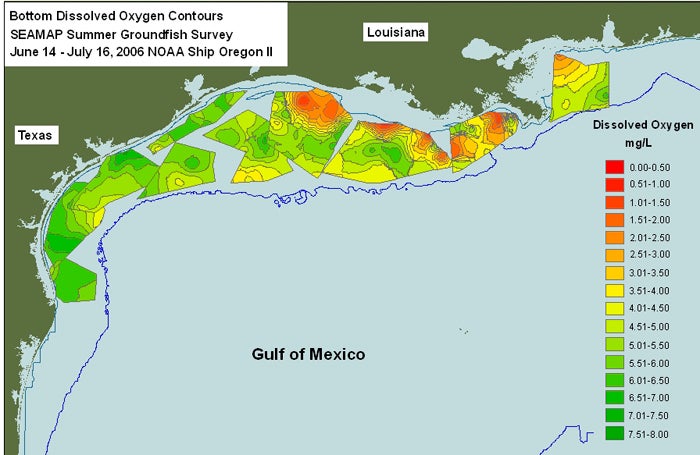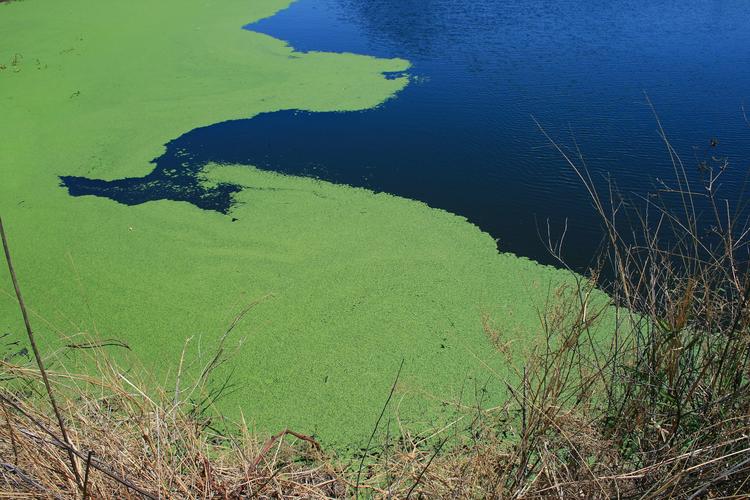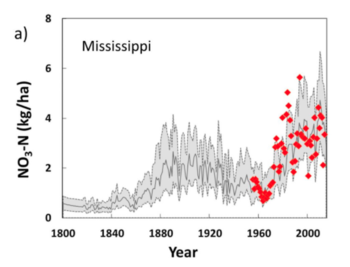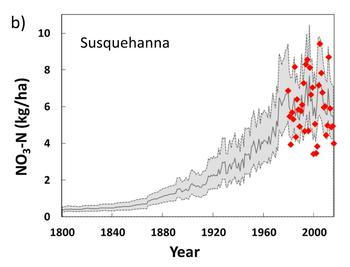Introduction
News of eutrophication and harmful algal blooms has become commonplace each summer, from Lake Erie to the Gulf of Mexico, from the Baltic Sea to China’s Lake Taihu. These overgrowths of algae, which disrupt aquatic ecosystems and in some cases can produce toxins that pose a threat to drinking water quality, are a result of an overabundance of nutrients. When excess nutrients such as nitrogen (N) and phosphorus flow through our rivers to lakes and coastal areas, algae "feed" on these nutrients. In a healthy waterbody, nutrients occur at low concentrations and are necessary to support the aquatic food web. At high concentrations, however, the rapid growth of algae and other plants can, in the short term, create an unpleasant scum on the water surface and limit the recreational use of the waterbody. In the long term, these algal overgrowths die and begin to decompose, taking up large amounts of oxygen in the water column, leading to the development of hypoxia, or "dead zones," where no aquatic organisms can live.

Figure 1. Bottom Dissolved Oxygen Contours, SEAMAP Summer Groundfish Survey. June 14 - July 16, 2006. NOAA Ship Oregon.
Both scientists and policy-makers have been aware of the eutrophication problem for decades. The word “eutrophication” was first coined in the scientific literature in 1921 by Einar Naumann, and numerous attempts to expand upon this early work began to appear in the 1960s and 1970s. During this same time period, policy-makers also began to take action to reduce problems of eutrophication in affected waterbodies, proposing legislation to limit the use of phosphorus in laundry detergent and requiring upgrades to wastewater treatment facilities. Since that time, watershed managers and conservation agencies have focused their efforts on control of nonpoint source contributions to nutrient pollution, and billions of dollars have been spent on a range of interventions, from the retirement of agricultural land to the planting of cover crops and the development of riparian buffer strips.
Despite such efforts, nitrogen and phosphorus loading to lakes and coastal areas continues to be a significant problem. For example, in 2008, the Mississippi River/Gulf of Mexico Watershed Nutrient Task Force set a goal of reducing the size of the Gulf’s dead zone to 5,000 km2 by the year 2015. In 2017, however, the size of this zone had increased to approximately 22,000 km2, more than four times the stated goal, despite the billions of dollars already spent on conservation measures (Figure 1).
Such disappointing results have made it clear that even with implementation of new and more effective agricultural management practices, it can take years – even decades – before we see measurable improvements in water quality. Nevertheless, it has remained difficult to predict exactly how long it will take to meet water quality goals, and what the specific controls are on the observed time lags. In our work, we have attempted to address this challenge by exploring long-term nutrient dynamics in watersheds as a function of agricultural production and other human activity.
Methodology
The present work began with the hypothesis that decades of both fertilizer application and intensive livestock production have led to the development of nutrient legacies within human-impacted watersheds, and that these legacies are a primary control on the time lags that are observed after implementation of conservation measures. Our previous research testing this hypothesis has provided emerging evidence of soil nitrogen accumulation in agricultural soils. In this study, we have explored long-term nitrogen dynamics within two watersheds responsible for the delivery of large nutrient loads to two coastal areas strongly impacted by eutrophication: the Gulf of Mexico and Chesapeake Bay. Our goal in this work was to use a modelling approach to better our understanding of the temporal patterns of nutrient loading within these river systems, to identify the sources of this loading, and to estimate the extent to which current nutrient loading is controlled by legacy sources of nitrogen.
To model these nutrient dynamics, it was first necessary to develop a dataset that could account for all inputs of nitrogen to and from the watersheds over time. To obtain such information, we synthesized data regarding agricultural practices, land-use trajectories, and population trends, taking into account everything from corn yields to the changing densities of pigs, chickens, and dairy cows across the United States. Agricultural data was obtained from the U.S. Department of Agriculture as far back as 1860, and agricultural inputs prior to that point were modelled based on long-term land-use data. This dataset was paired with our newly developed model, ELEMeNT (Exploration of Long-tErM Nutrient Trajectories), which is designed to capture the development of legacy nutrient accumulations within soils, sediments, and groundwater.

Outcomes
Our results first allowed us to model nitrogen loading over time, from 1800 to the present (Figure 2). As expected, these loading trajectories allowed us to show the large increases in nitrogen loading associated with increases in fertilizer inputs and the intensification of agriculture that occurred in the mid-20th century. However, for the Mississippi Basin they also show large increases in nitrogen loading during the mid-1800s, increases that are associated with the dramatic changes in land use, as European settlers crossed the Midwestern landscape and converted pristine prairie lands into row-crop agriculture.


Figure 2. Long-term nitrate loading to the Mississippi and Susquehanna Rivers, as predicted using the ELEMeNT model. Red diamonds represent measured N loads, while the black line represents the modelled values. The grey area indicates the 95% confidence interval based on the calibrated parameter values.
Perhaps most importantly, our analysis showed that current water quality is profoundly impacted by the past. In the Susquehanna River Basin, which is dominated by urban development, our results suggest that approximately half of the current nitrogen loading to the Chesapeake Bay is legacy nitrogen. In the Mississippi, where population density is lower and where agriculture is a dominant source of nitrogen, the impact of legacy is greater, with more than 85% of nitrogen being associated with past-year nitrogen inputs.
Conclusions
The implications of these nutrient legacies are tremendous. Even with the adoption of very aggressive management practices, it can take decades to achieve meaningful reductions in the eutrophication risk of downstream waterbodies. Subsequent studies are focusing on the ability to better predict the time required to achieve improvements in water quality, which will allow us to more realistically set policy targets, and to more accurately gauge the costs and benefits of implementing new management practices.
Van Meter, K.J., N.B. Basu, and P. Van Cappellen (2017). Two centuries of nitrogen dynamics: legacy sources and sinks in the Mississippi and Susquehanna River basins. Global Biogeochemical Cycles 31, 2-23.
Contact: Nandita Basu, Department of Earth and Environmental Sciences and Department of Civil and Environmental Engineering; Kimberly Van Meter, Department of Earth and Environmental Sciences; Philippe Van Cappellen, Department of Earth and Environmental Sciences
For more information about the Water Institute, contact Amy Geddes.







